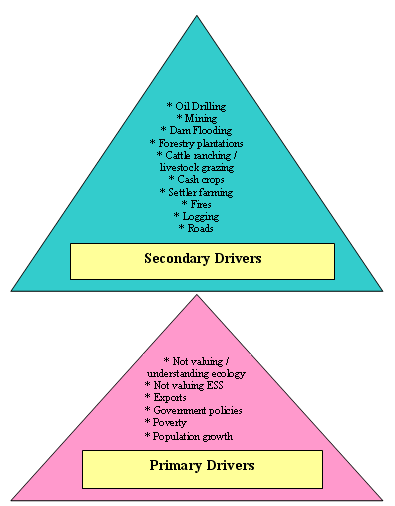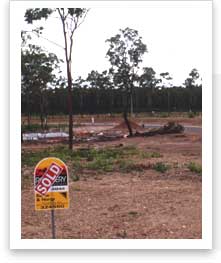Drivers of Degradation and Deforestation in Tropical Ecosystems
Primary Drivers of Degradation
The processes of degradation and deforestation in tropical environments are the result of a number of interconnected primary and secondary causes which vary depending on the ecosystem type, location (particularly whether the country is a developed or developing), and the unique ecology and land-use pressures on the system.
The primary causes of tropical deforestation and degradation are widely acknowledged to be population growth, poverty, environmentally harmful government subsidies, debts owed to developed countries leading to environmentally unsustainable exports, failure to value and understand the ecology of these systems, and as a consequence failure to value the ecological services (ESS) provide by tropical savannas and rainforests (Geist and Lambin 2002; Miller 2005; Sodhi and Brook 2006). These six factors can be thought of as the primary drivers of degradation from which a vast array of secondary drivers arise. The importance of each of these primary drivers varies greatly between countries and areas as illustrated by the readings below.
Secondary Drivers of Degradation
There are a number of different secondary drivers that can contribute to the degradation and deforestation of tropical ecosystems, as illustrated in Figure 4.1.

Figure 4.1. Natural Capital Degradation: Major Interconnected Primary and Secondary Causes of Deforestation and Degradation of Tropical Rainforest and Savanna Ecosystems, after Miller (2005)
These drivers are often responsible for physically removing or altering vegetation and initiating processes of degradation, for example grazing leading to woody thickening in savannas, or logging of tropical rainforest, however, they are not the root cause of the degradation. Alternatively one or more of the primary drivers identified above can be identified as the underlying cause of the natural capital degradation in these ecosystems. As discussed in Module 3 fire is a natural phenomena of tropical savannas, however, it is the way human activities has altered fire regimes in savanna ecosystems that have produced a secondary driver of degradation out of a natural factor in tropical savannas.
![]()
Activity 4.1
Answer with reference to the following reading:
- Geist, H.J. & Lambin, E.F. (2002) “Proximate causes and underlying driving forces of tropical deforestation” Bioscience 52 (2) 143-150.
Q1 Primary drivers are referred to by Geist & Lambin (2002) as underlying causes and secondary causes as proximate causes. The authors recognises five categories of underlying forces, what are these categories, how do they match-up to the primary drivers listed above, and are each of these categories.
![]()
Underlying causes:
- Demographic factors (essentially populations and population growth)
- Economic factors (markets, economic structures, urbanisation/industrialisation
- Technological factors (agroforestry technical change, ag production factors)
- Policy & institutional factors (formal policies, policy climate (corruption, mismanagement etc, property rights)
- Cultural factors (public attitudes, values and beliefs, individual and household behaviour)
Q2 What are the categories of proximate, i.e. secondary drivers recognised by Geist & Lambin (2002)?
![]()
Proximate causes:
- Infrastructure extension (predominantly roads)
- Agricultural expansion
- Wood extraction
Q3 List in order of importance the proximate causes associated with tropical deforestation worldwide and comment on their global distribution.
![]()
The leading proximate causes of tropical deforestation globally were identified by Geist & Lambin (2002) as being extension of transport infrastructure, commercial wood extraction, permanent cultivation, and cattle ranching. Agricultural expansion for shifting cultivation, permanent cultivation, pasture for cattle ranching (almost exclusively in humid mainland South America), is associated with 96% of deforestation cases examined by this study. Commercial wood extraction is frequent and mainly for commercial production in Asia, whereas in Africa it is mainly for fuel wood and poles for individual domestic use. Road construction is by far the most frequently reported form of infrastructure expansion, mainly in lowland and mountain cases in Latin America. Predisposing environmental factors such as land characteristics or trigger events were reported to influence nearly 1/3 of reported cases.
Q4 What were identified by Geist & Lambin (2002) as the predominant underlying forces of tropical deforestation? What was identified as an insignificant factor?
![]()
Predominant underlying forces were identified as:
- Economic factors
- Institutional factors
- Technological factors (although not actually primary drivers) Cultural or socio-political factors
- Demographic factors (although only in-migration into sparsely populated forest areas)
Population increase due to high fertility rates was only reported in 8% of cases and always with other associated factors, and therefore an insignificant factor contrary to common misconceptions.
Q5 What patterns of causal interactions do Geist & Lambin (2002) identify?
![]()
Policy and institutional factors in association with economic factors lead to the necessity of road infrastructure that is associated with wood extractions and/or agricultural expansion.
Africa – insecure land ownership, shift from communal to private property, leading to traditional shifting cultivation causing deforestation.
Latin America - underlying cause of land policies directed toward degradation.
etc.
The Role of Environmental Factors
The effect of human induced secondary drivers can be exacerbated by environmental factors, such as storm events (e.g. heavy rains, cyclones) and climate, as well as inherent ecosystem vulnerabilities (e.g. soil structure, species and community ecology). This is demonstrated by Nunn (Nunn 1990) and is an important factor to consider when designing and implementing regionally appropriate natural resource management.
![]()
Activity 4.2
Identifying primary and secondary drivers of deforestation and degradation of tropical ecosystems.
Read the following:
- Sodhi, N.S. & Brook, B.W. (2006) “Dwindling Habitats” in “Southeast Asian Biodiversity in Crisis” Cambridge Tropical Biological Series, Cambridge University Press, Cambridge, UK.
- Nunn, P.D. (1990) “Recent Environmental Change on Pacific Islands” The Geographical Journal 156 (2) 125-140 Extract pp131-133.
Q1 Identify the primary and secondary drivers of southeast Asian deforestation discussed by Sodhi & Brook (2006).
![]()
Primary Drivers:
- Population
- Government policies & weak government enforcement
- Lack of value given to ecosystem services
Secondary Drivers:
- Commercial logging
Q2 Discuss the human induced and environmental induced drivers of degradation and deforestation of pacific islands discussed by Nunn (1990).
![]()
Human induced drivers following contact with Europeans:
- demand for commercial agricultural products and cash crops(domestic and overseas markets rather than subsistence living
- demand for wood products
- demand for mining products
Primary drivers were/are exports, population growth in newly developed urban centres.
Secondary drivers poorly managed and executed agriculture, logging and mining.
Environmentally induced drivers:
- large storms and cyclones leading to numerous and devastating mudslides and significant soil loss (evidence that these are equally or more influential factors in erosion and soil loss is that the majority of mudslides in the Waimanu catchment during a major rain storm in 1986 were in agriculturally undeveloped forested areas).
Next topic - Ecosystem services and sustainable management of tropical ecosystems
Topics in this module
- Introduction
- Management issues & drivers of degradation and deforestaton
- Ecosystem services and sustainable management of tropical ecosystems
- Application of the ESS concept for sustainable management of tropical ecosystems
- Management of human interactions with tropical ecosystems
- Compulsory readings




